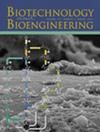电刺激辅助CS/凝胶/MWCNTs导电支架在皮肤组织工程中的应用
IF 3.5
2区 生物学
Q2 BIOTECHNOLOGY & APPLIED MICROBIOLOGY
引用次数: 0
摘要
水凝胶支架具有良好的力学性能和生物相容性,在组织工程中具有很大的应用潜力。然而,固有的导电性不足限制了其在需要电刺激的领域的应用。为了解决这一问题,用不同浓度的多壁碳纳米管(MWCNTs)制备了壳聚糖(CS)/明胶(Gel)支架。结果表明,MWCNT的掺入显著提高了支架的导电性和机械强度,与其他配方相比,CS/Gel/0.3% MWCNT支架具有更好的生物相容性。此外,植入支架的成纤维细胞对电刺激反应积极,显示增殖增加,I型和III型胶原蛋白表达升高。这些发现突出了CS/Gel/MWCNTs支架在皮肤组织工程中促进伤口愈合的潜力。本文章由计算机程序翻译,如有差异,请以英文原文为准。
CS/Gel/MWCNTs Conductive Scaffolds Assisted by Electrical Stimulus for Skin Tissue Engineering.
Hydrogel scaffolds show high potential in tissue engineering due to excellent mechanical properties and biocompatibility. However, an inherent lack of conductivity limits its application in areas requiring electrical stimulation. To address this issue, chitosan (CS)/gelatin (Gel) scaffolds were prepared with various concentrations of multi-walled carbon nanotubes (MWCNTs). Results indicated that MWCNT incorporation significantly improved both the electrical conductivity and mechanical strength of the scaffolds, with the CS/Gel/0.3% MWCNTs scaffold demonstrating superior biocompatibility compared to other formulations. Additionally, fibroblasts seeded onto the scaffolds responded positively to electrical stimulation, showing increased proliferation and elevated expression of type I and type III collagen. These findings highlight the potential of CS/Gel/MWCNTs scaffolds to enhance wound healing in skin tissue engineering.
求助全文
通过发布文献求助,成功后即可免费获取论文全文。
去求助
来源期刊

Biotechnology and Bioengineering
工程技术-生物工程与应用微生物
CiteScore
7.90
自引率
5.30%
发文量
280
审稿时长
2.1 months
期刊介绍:
Biotechnology & Bioengineering publishes Perspectives, Articles, Reviews, Mini-Reviews, and Communications to the Editor that embrace all aspects of biotechnology. These include:
-Enzyme systems and their applications, including enzyme reactors, purification, and applied aspects of protein engineering
-Animal-cell biotechnology, including media development
-Applied aspects of cellular physiology, metabolism, and energetics
-Biocatalysis and applied enzymology, including enzyme reactors, protein engineering, and nanobiotechnology
-Biothermodynamics
-Biofuels, including biomass and renewable resource engineering
-Biomaterials, including delivery systems and materials for tissue engineering
-Bioprocess engineering, including kinetics and modeling of biological systems, transport phenomena in bioreactors, bioreactor design, monitoring, and control
-Biosensors and instrumentation
-Computational and systems biology, including bioinformatics and genomic/proteomic studies
-Environmental biotechnology, including biofilms, algal systems, and bioremediation
-Metabolic and cellular engineering
-Plant-cell biotechnology
-Spectroscopic and other analytical techniques for biotechnological applications
-Synthetic biology
-Tissue engineering, stem-cell bioengineering, regenerative medicine, gene therapy and delivery systems
The editors will consider papers for publication based on novelty, their immediate or future impact on biotechnological processes, and their contribution to the advancement of biochemical engineering science. Submission of papers dealing with routine aspects of bioprocessing, description of established equipment, and routine applications of established methodologies (e.g., control strategies, modeling, experimental methods) is discouraged. Theoretical papers will be judged based on the novelty of the approach and their potential impact, or on their novel capability to predict and elucidate experimental observations.
 求助内容:
求助内容: 应助结果提醒方式:
应助结果提醒方式:


